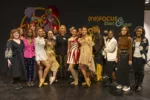—History of Africans brought to America is an undercurrent in the works at Bridgette Mayer gallery this month. Chip explains the artist’s methods and themes in his review.–the artblog editors——————>Radcliffe Bailey‘s premier solo exhibition at Bridgette Mayer Gallery pulls the viewer into a world that is both chaotic and precise, contemporary and historical. Utilizing a diverse range of mediums from steel, bronze, porcelain, wood, glass, and collage, Bailey, a New Jersey-born, Atlanta-based artist, breaks down and rebuilds his surroundings into silent, dignified compositions that are simultaneously ruinous and stalwart.
While a significant portion of the show is full of Bailey’s two-dimensional collages, his sculptural explorations are a definite standout – both figuratively and literally.
These assemblages are wall-mounted and a few pieces tumble with the disassembled inner-workings of former pianos, lending themselves to the imagery of dysfunctional machines or natural disaster areas. If topped with torn-up shingles and adjoined to a collapsed garage, these piles could easily mark the destructive wake of a tornado or earthquake.
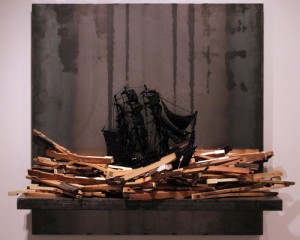
In “Nest,” Bailey perches a tiny, taxidermy falcon atop a hill of broken piano keys backed by – as is common in this show – a solid sheet of steel. The scratchy and slightly shiny texture of this metallic landscape becomes a dense fog in which the falcon seems to be immersed and staring through. Another different sort of perch comes to mind by way of the nautical. A glittery black ship complete with towering masts calls to mind the crow’s nest lookouts of old, and sails the wooden waves toward parts unknown.
Entitled “Out of the Blue,” this piece surely implicates European colonialism in the plight of Bailey’s African ancestors and the means by which they were taken, completely without warning, from their homes.
The silhouette of such a vessel on the horizon must have signaled social and personal eradication on a scale we can scarcely perceive from our contemporary vantage point.
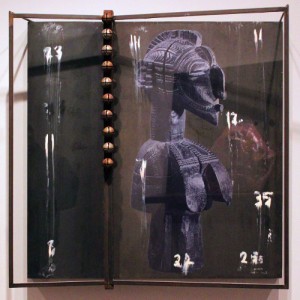
Other steely constructions include open, glass fronts which angle outward like an open book. The depth and framing of these components adds a degree of distance as well as multiple facets by which we may look at the objects beneath. Rusty bells, dripping, painted numbers, and an ancient African sculpture make up “Currency,” whose hard edges and sloppy scrawls make it seem robust but emotionally distant. As a counterpoint, “Double Consciousness” displays two wax replicas of the same realistic head, separated by a middle divider. The almost pained reactions of these faces make it considerably more fervent than many of its companions despite its obvious duality.
Lives and families torn apart, cultures and societies invaded, and even the internal battles with oneself are represented in this piece. Interestingly, it also contains the least material of any work in the exhibit, relying solely on the metal framework and two wax busts to tell a grand tale.
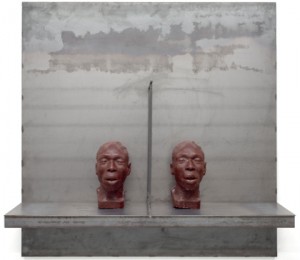
Much of the front part of the gallery is lined with Bailey’s collages. A good deal of the images here are crossovers with his sculptural creations, but doused with splashes of color and line work that are notably absent in the 3D objects he provides. Photos of figurative African sculptures, their wooden bodies adorned with chiseled textures and anatomically abstract body parts, wade amongst these color studies. Observing the background layers, it is apparent that Bailey applied these parts to old pages of sheet music, their notes dancing beneath and around the bodies. The parallels between deconstructed pianos and their quintessentially Western musical scales and these partly-covered notations become very clear as a powerful and overarching theme throughout the entire show.
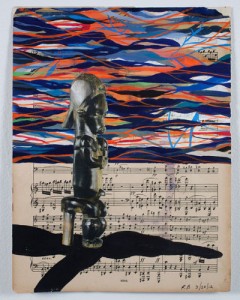
Radcliffe Bailey examines the past and present through the lens of contemporary montage – both sculptural and flat. Conceived with an eye that is complex in its formal workmanship, his artwork is both highly personal and culturally sensitive.
The work of Radcliffe Bailey will be on display at Bridgette Mayer Gallery through April 27.




